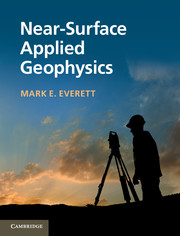Book contents
- Frontmatter
- Contents
- Preface
- Acknowledgments
- 1 Introduction
- 2 Data analysis
- 3 Magnetics
- 4 Electrical resistivity method
- 5 Induced polarization and self-potential
- 6 Seismic reflection and refraction
- 7 Seismic surface-wave analysis
- 8 Electromagnetic induction
- 9 Ground-penetrating radar
- 10 Emerging techniques
- 11 Linear inversion
- 12 Non-linear inversion: local methods
- 13 Non-linear inversion: global methods
- Appendix A Shannon sampling theorem
- Appendix B Solution of Laplace’s equation in spherical coordinates
- Appendix C The linear τ–p transformation of seismic data
- Appendix D Horizontal loop over a conducting halfspace
- Appendix E Radar TE waveguide mode equations
- References
- Index
- Plate section
3 - Magnetics
Published online by Cambridge University Press: 05 April 2013
- Frontmatter
- Contents
- Preface
- Acknowledgments
- 1 Introduction
- 2 Data analysis
- 3 Magnetics
- 4 Electrical resistivity method
- 5 Induced polarization and self-potential
- 6 Seismic reflection and refraction
- 7 Seismic surface-wave analysis
- 8 Electromagnetic induction
- 9 Ground-penetrating radar
- 10 Emerging techniques
- 11 Linear inversion
- 12 Non-linear inversion: local methods
- 13 Non-linear inversion: global methods
- Appendix A Shannon sampling theorem
- Appendix B Solution of Laplace’s equation in spherical coordinates
- Appendix C The linear τ–p transformation of seismic data
- Appendix D Horizontal loop over a conducting halfspace
- Appendix E Radar TE waveguide mode equations
- References
- Index
- Plate section
Summary
The purpose of the magnetic geophysical technique is to explore the spatial distribution of magnetized rocks and buried ferrous metal objects, based on magnetic measurements made at or near the surface, and then to make a geological or anthropogenic interpretation in terms of the objectives of the investigation. The magnetic method is perhaps the oldest of geophysical exploration techniques (Nabighian et al., 2005).
The magnetic method has become widely used in near-surface geophysics for several reasons (Hansen et al., 2005): (a) buried targets or geological structures of interest often have readily detectable magnetic signatures owing to the high sensitivity of modern magnetometers; (b) the measurements are fast, reliable, and non-invasive; (c) magnetic data are often straightforward to interpret using qualitative and quantitative techniques, especially when large amounts of high-resolution data are acquired over a wide area such that a continuous plan view of the site and its surroundings can be obtained.
- Type
- Chapter
- Information
- Near-Surface Applied Geophysics , pp. 34 - 69Publisher: Cambridge University PressPrint publication year: 2013
- 1
- Cited by



